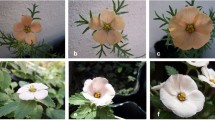Abstract
THE discovery of a tetraploid form of Primula farinosa on the Baltic island of Gotland during the summer of 1950 was somewhat unexpected, as hitherto this plant has seemed a well-defined diploid species (n = 9), at least in Central and Northern Europe. This tetraploid form revealed n = 18 at meiosis (Fig. 1), and the plant appeared morphologically distinct from the British Primula, with more elongated spatulate leaves (Fig. 4).
Similar content being viewed by others
References
Brunn, N. G., Sym. Bot. Upsal., 1 (1932).
Wright-Smith, W., Trans. Roy. Soc. Edin. (1949).
Author information
Authors and Affiliations
Rights and permissions
About this article
Cite this article
DAVIES, E. Polyploidy in Primula farinosa L.. Nature 171, 659–660 (1953). https://doi.org/10.1038/171659a0
Issue Date:
DOI: https://doi.org/10.1038/171659a0
- Springer Nature Limited




